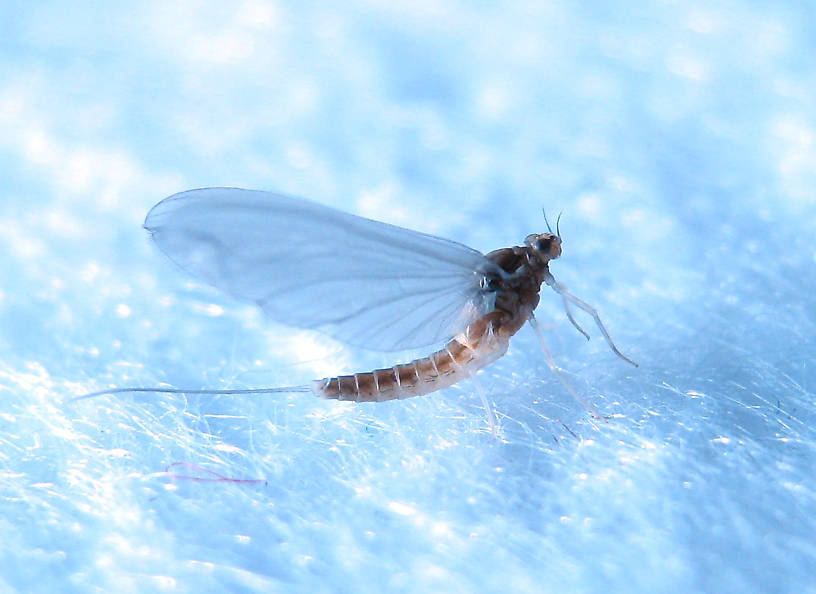
Hex Mayflies
Hexagenia limbata
The famous nocturnal Hex hatch of the Midwest (and a few other lucky locations) stirs to the surface mythically large brown trout that only touch streamers for the rest of the year.


Mayfly Species Anafroptilum album (Tiny Sulphur Duns)
Taxonomic History
Where & when
Time of year : June to October
Preferred waters: Streams and lakes
In 10 records from GBIF, adults of this species have been collected during June (60%), August (20%), September (10%), and July (10%).
In 2 records from GBIF, this species has been collected at elevations of 2854 and 3953 ft.
Species Range
Nymph biology
Current speed: Slow to moderate
Environmental tolerance: Prefers warm water
Physical description
Most physical descriptions on Troutnut are direct or slightly edited quotes from the original scientific sources describing or updating the species, although there may be errors in copying them to this website. Such descriptions aren't always definitive, because species often turn out to be more variable than the original describers observed. In some cases, only a single specimen was described! However, they are useful starting points.
Male Spinner
Wing length: 4-6 mm
Abdominal tergites 2-6 of male imago entirely hyaline.
Turbinate eyes dull orange-brown, in dried specimen. Head blackish brown; whitish ochreous tinges in median area behind ocelli. Pronotum blackish with paler patches laterally. Mesonotum pale ochreous with brown shading; scutellum and posterior portion almost entirely white, shaded faintly with pink. Metanotum deep brown; anterior margin white with pinkish shading and a median dark dot. Pleura and sternum mostly deep brown, with faint white shading at the intersegmental areas. Legs white. Wings hyaline, venation pale. Hind wing very narrow, much as in C. fragile (now a synonym of Procloeon fragile), but not quite as long; costal projection prominent. Abdominal segments 2-6 entirely hyaline; segments 7-10 opaque whitish. Tails white. A slight inward bulge on the inner margin of the second forceps joint.
This species is allied closely to C. convexum (now a synonym of Anafroptilum album); the hind wings are considerably more narrow than in that species, and the tubercle on the second forceps joint less well developed.
Described as C. convexum
Body length 4 mm, wing length 5 mm
Abdominal tergites 2-6 of male imago hyaline white, sometimes with a median pinkish shading.
Turbinate eyes pale chestnut brown in dried specimen. Head brown, with darker brown markings at bases of antennae and on median carina. Prothorax brown. Mesonotum brown, the pleura and scutellum marked with ochreous white. Metanotum pinkish on the anterior margin, brown in posterior half. Legs pale yellowish. Wings hyaline. Hind wing moderately broad, the costal projection prominent (see fig. 165).
Abdominal segments 2-6 hyaline white, sometimes tinged faintly with pinkish in the median area. Segments 7-10 opaque white, the tergites with a pink flush, most noticeable on 9, where it appears as a pink lateral border. Tails white. Second joint of forceps with a distinct inwardly projecting tubercle.
From the closely-allied C. album (now a synonym of Anafroptilum album), this species may be separated by the pink lateral margin on tergite 9, the somewhat darker thorax, the wider hind wing, and the greater development of the tubercle on the second forceps joint. It is somewhat smaller than C. walshi (now a synonym of Anafroptilum album), and is distinguished from it by the brown thoracic sternum and posterior half of the metanotum, which areas are creamy white in C. walshi.
Described as C. walshi
Body length 6 mm, wing length 6 mm
Abdominal segments 2-6 of male imago hyaline white, with no markings except a broken black spiracular line.
Turbinate eyes pale yellow in living insect, bright reddish in dried specimen. Pronotum light ochreous brown; mesonotum similar, shading into creamy on the posterior third. Metanotum and all of the sternum creamy. Legs whitish. Wings hyaline, venation pale. Abdominal segments 2-6 hyaline white, with a broken black line along the spiracular area. Tergites 7-10 opaque, creamy, shaded with light purplish brown (perhaps due to discoloration); sternites similar, but with no dark shading. Tails whitish. Between the bases of the forceps is a plate having a convex posterior margin. The inner margin of the second forceps joint bears a distinct tubercle.
This species may be distinguished from the allied C. album (now a synonym of Anaafroptilum album) by the stronger tubercle on the second forceps joint, and the pale metanotum and thoracic sternum; these areas are wood-brown in album, which is also considerably smaller in size.
Nymph
The gills of the nymph are single on all segments; the dorsum of the abdomen is largely shaded with dark color.
Described as C. convexum
The nymph is closely allied to C. album (now a synonym of Anafroptilum album), with single gills on all segments, but the dorsal abdominal markings are more restricted, the last four segments being largely pale.
Specimens of the Mayfly Species Anafroptilum album
1 Female Dun

Start a Discussion of Anafroptilum album
References
- Caucci, Al and Nastasi, Bob. 2004. Hatches II. The Lyons Press.
- Knopp, Malcolm and Robert Cormier. 1997. Mayflies: An Angler's Study of Trout Water Ephemeroptera . The Lyons Press.
- Leonard, Justin W. and Fannie A. Leonard. 1962. Mayflies of Michigan Trout Streams. Cranbrook Institute of Science.
- Needham, James G., Jay R. Traver, and Yin-Chi Hsu. 1935. The Biology of Mayflies. Comstock Publishing Company, Inc.
Mayfly Species Anafroptilum album (Tiny Sulphur Duns)
Species Range
Common Names
Resources
- NatureServe
- Integrated Taxonomic Information System
- Global Biodiversity Information Facility
- Described by McDunnough (1926)

